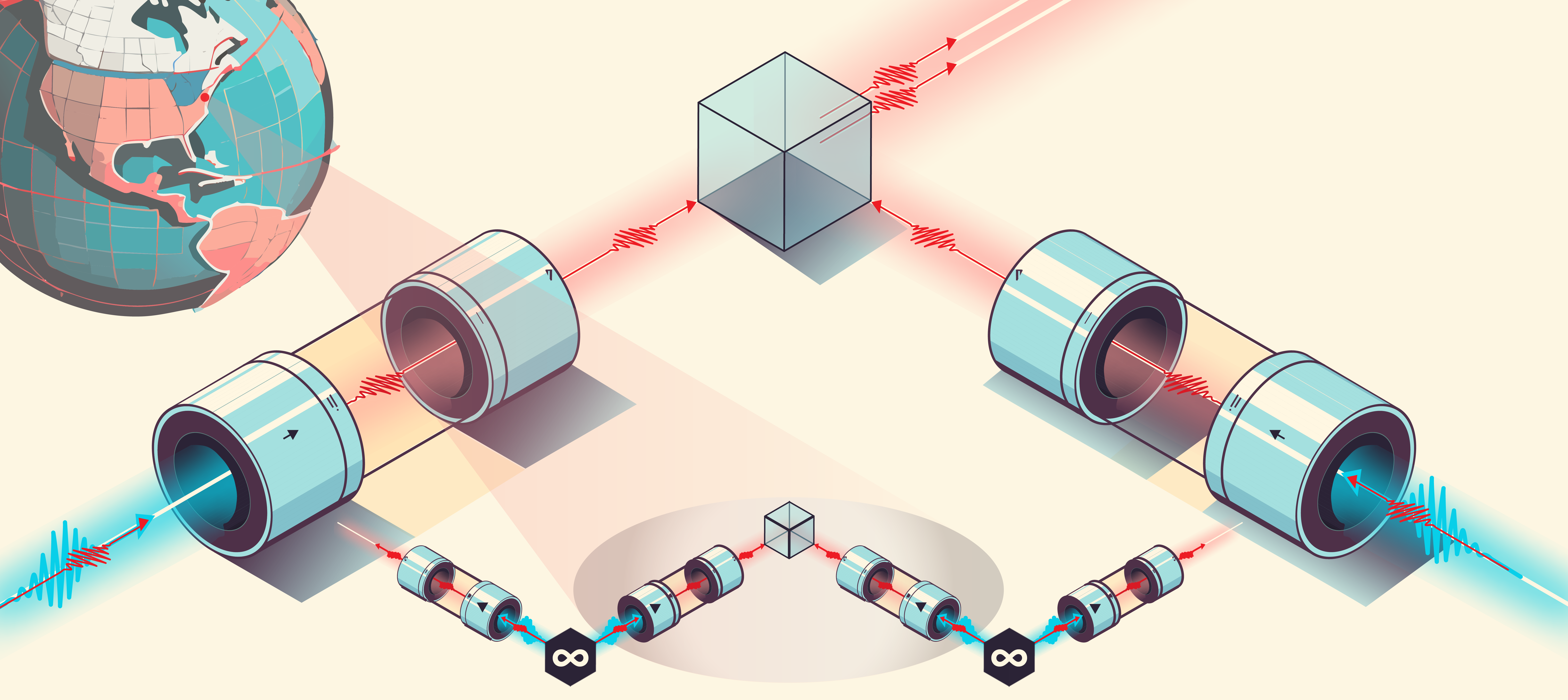Quantum Repeaters
The simplest distribution of entanglement between a fixed pair of destinations is to have a source of entangled pairs, which are sent to the two locations. This transmission scenario from a single source will ultimately be limited in distance simply by attenuation and/or noise. Practically, the attenuation of single photons in commercial telecom fibers will limit single-pair runs to distances on the order of 100 km or less. The approach to extending the range of entanglement pair distribution is that of the quantum repeater. Unlike the operation of a classical repeater, the quantum repeater does not amplify; instead, the quantum repeater can hop the entanglement property across an additional distance interval by consuming the resource of a second entangled pair. Practically, the four innovations needed to carry this out are: (i) heralded QMs, (ii) telecom ESs tuned to interoperate with QMs, (iii) quantum frequency converters (QFCs) from telecom to QM-compatible IR wavelengths and (iv) a monitored process of entanglement swapping. Figure 4 shows the essential elements of a one-hop, first-generation quantum repeater.

Based on entanglement swapping, a quantum repeater hop can increase the entanglement distribution distance. Two pairs of entangled photons are generated at Substation 1 and Substation 3 respectively, and their members propagate to the quantum memories of the Alice and Bob nodes and of the intermediate node at Substation 2. There, a Bell State Measurement (BSM) is performed, thereby entangling the photons at Alice and Bob.
Improved distance transmission with a QR is realized by QMs, which can buffer a pair after a successful transmission without requiring the other pair’s survival at exactly the same time. The protocol is as follows: (i) In a given time interval, each ES (substations 1 and 3) sends its particles to the pair of QMs at the ends of the links. (ii) Each pair of QMs receiving from the same ES are non-destructively probed (heralded) to confirm that the entangled pairs arrived and are stored successfully. (iii) If the transmission and storage of only one of the entangled pairs succeed, then that pair is held in its QMs while another attempt is made to transmit and store the other pair on a subsequent time interval. (iv) Once both pair transmission and storage operations have succeeded and all four QMs are occupied, then the two QMs in the central swapping station are read out and put through the BSM, effectively swapping the entanglement.

Stylized depiction of the process of memory assisted entanglement swapping. Here we see two uncorrilated photons entering the quantum memories, being stored for different times to then be released at the same time to swap entanglement at the central point.
The now-entangled qubits, at Alice and Bob, can be read out of the distantly-located QMs. This approach yields a memory advantage, as the overall success of the procedure hinges on two successful pair transmissions and storage within the memory's duration. This scenario is significantly more likely than both pair transmissions and storages occurring simultaneously within a single time interval. Developing the interconnected and interoperable building blocks to demonstrate this procedure is the core of these research activity.

The map of the New York State Quantum Internet Testbed (NYSQIT), including the fiber connections that form the backbone of the quantum repeater demonstration experiments. The first segment connects SBU to Brooklyn, spanning ~119 km, with access to one CF in Westbury. The second segment connects SBU and the CF in Commack, with access to the BNL QIST laboratory, spanning ~140 km. A third segment, connecting Brooklyn to CU, with access to the Manhattan Landing (MANLAN) CF, is currently under development. A free-space link connecting BNL, SBU, and YU is also under development.
Verification of QR principles using NYSQIT
The advanced building blocks of functional QRs will be verified in NYSQIT. We will validate the QR network building blocks by using two entanglement sources, four quantum memories, one BSM setup, and two single photon detection modules:
Bipartite Entanglement Distribution
Having established node-to-node classical communication and control, we will pursue the distribution of polarization entanglement between a fixed pair of destinations in the NYSQIT. We will use sources of entangled photons tuned to telecom operation (1324 nm). The sources will be located at BNL and Westbury (WBY). After polarization compensation in the quantum links, we will perform coincidence measurements for different bases at the endpoints to demonstrate the violation of a Bell inequality.
Entangled Quantum Interconnects
Our next step will be to create entangled states between two distant quantum memories at the endpoints of the configurations mentioned above. We will first create and store a four-photon state in an entanglement-swapping configuration. One photon from each pair source at BNL and WBY will be stored in quantum memories at SBU, and the two other photons will be stored in quantum memories at Commack (CMK) and Brooklyn (QNT). Storage times of these memories will be long enough for the other photons to transverse the fiber links (latency>200 μs) and then be stored and heralded.
